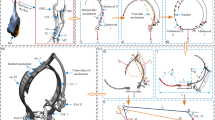Abstract
This paper is devoted to the important problem of subsea infrastructure inspection using autonomous underwater vehicles (AUVs). The accomplishment of the inspection mission requires high accuracy of AUV coordination with respect to objects, which is not always provided by standard hydroacoustic equipment. That is why we propose an approach based on stereo image processing that can provide submeter accuracy of AUV coordination required under subsea conditions. In the framework of a unified approach based on the use of an a priori formed point model of an object and the application of a structural coherence criterion, we propose and analyze several methods for recognition of underwater objects and coordinate referencing of the AUV to these objects. As a geometric model of an object, we consider its representation based on characteristic points, which determines the spatial structure of the object. In addition to the standard method for object model construction from preliminary measurements, a new method is proposed, which is based on automated technique of model generation from images offline. The proposed object recognition methods use the structural coherence criterion to match 3D point clouds with object models. The 3D point clouds are formed from stereo images captured by a camera using visual navigation. Feature points are generated and matched using the SURF detector and Harris corner detector. To improve the reliability of object identification, we propose joint processing of source images with their vectorized forms. The use of line segments obtained by vectorization significantly increases the number of identified characteristic points when matching a 3D point cloud with a model. Based on the identified points of an object, the matrix of AUV coordinate referencing to this object is computed. The efficiency of the considered methods is estimated and compared. In the computational experiments with model scenes, a virtual geometric model of a distributed subsea production system is used. The experiments on real-world data are carried out under laboratory conditions with the use of a Karmin2 stereo camera (Nerian’s 3D stereo camera, baseline 25 cm).





Similar content being viewed by others
REFERENCES
Mai, C., Pedersen, S., Hansen, L., Jepsen, K., and Yang, Zh., Subsea infrastructure inspection: A review study, Proc. 6th Int. Conf. Underwater System Technology: Theory and Applications, 2016. https://doi.org/10.1109/USYS.2016.7893928
Manley, J.E., Halpin, S., Radford, N., and Ondler, M., Aquanaut: A new tool for subsea inspection and intervention, Proc. OCEANS MTS/IEEE Conf., Charleston, 2018. https://doi.org/10.1109/OCEANS.2018.8604508
Zhang, Yu., Zheng, M., An, Ch., and Seo, J.K., A review of the integrity management of subsea production systems: Inspection and monitoring methods, Ships Offshore Struct., 2019, vol. 14, no. 8, pp. 1–15. https://doi.org/10.1080/17445302.2019.1565071
Nister, D., Naroditsky, O., and Bergen, J., Visual odometry, Proc. Int. Conf. Computer Vision and Pattern Recognition, 2004, pp. 652–659. https://doi.org/10.1109/CVPR.2004.1315094
Jacobi, M., Autonomous inspection of underwater structures, Rob. Auton. Syst., 2015, vol. 67, no. C, pp. 80–86. https://doi.org/10.1134/S2075108718010042
Hou, Y.Z., Pan, Sh., and Dai, Ch., A novel underwater simultaneous localization and mapping online algorithm based on neural network, Int. J. Geo-Inf., 2019, vol. 9, no. 1, p. 5. https://doi.org/10.3390/ijgi9010005
Santos, M., Guilherme, Z., Otávio, R.P., Drews-Jr, P., and Botelho, S., Underwater place recognition using forward-looking sonar images: A topological approach, J. Field Rob., 2019, pp. 355–369. https://doi.org/10.1002/rob.21822
Jongdae Jung, Ji-Hong Li, Hyun-Taek Choi, and Hyun Myung, Localization of AUVs using visual information of underwater structures and artificial landmarks, Intel. Serv. Rob., 2017, vol. 10, pp. 67–76.
Bao, J., Li, D., Qiao, X., and Rauschenbach, T., Integrated navigation for autonomous underwater vehicles in aquaculture: A review, Inf. Process. Agric., 2020, vol. 7, no. 1, pp. 139–151. https://doi.org/10.1016/j.inpa.2019.04.003
Vidal, E., Palomeras, N., Istenič, K., Gracias, N., and Carreras, M., Multisensor online 3D view planning for autonomous underwater exploration, J. Field Rob., 2020, pp. 1123–1147. https://doi.org/10.1002/rob.21951
Bobkov, V.A., Kudryashov, A.P., and Inzartsev, A.V., Technology of AUV high-precision referencing to inspected object, Gyroscopy Navig., 2019, vol. 10, no. 4, pp. 322–329. https://doi.org/10.1134/S2075108719040060
Bobkov, V., Kudryashov, A., and Inzartsev, A., Method for the coordination of referencing of autonomous underwater vehicles to man-made objects using stereo images, J. Mar. Sci. Eng., 2021, vol. 9, p. 1038. https://doi.org/10.3390/jmse9091038
Palomer, A., Ridao, P., and Ribas, D., Inspection of an underwater structure using point-cloud SLAM with an AUV and a laser scanner, J. Field Rob., 2019, pp. 1333–1344. https://doi.org/10.1002/rob.21907
Himri, K., Ridao, P., and Gracias, N., 3D object recognition based on point clouds in underwater environment with global descriptors: A survey, Sensors, 2019, vol. 19, p. 4451. https://doi.org/10.3390/s19204451
Funding
This work was supported by the Russian Science Foundation, project no. 22-11-00032 (httрs://rscf.ru/en/рrоjесt/22-11-00032).
Author information
Authors and Affiliations
Corresponding authors
Ethics declarations
The authors declare that they have no conflicts of interest.
Additional information
Translated by Yu. Kornienko
Rights and permissions
About this article
Cite this article
Bobkov, V.A., Kudryashov, A.P. & Inzartsev, A.V. Object Recognition and Coordinate Referencing of an Autonomous Underwater Vehicle to Objects via Video Stream. Program Comput Soft 48, 301–311 (2022). https://doi.org/10.1134/S0361768822050024
Received:
Revised:
Accepted:
Published:
Issue Date:
DOI: https://doi.org/10.1134/S0361768822050024




